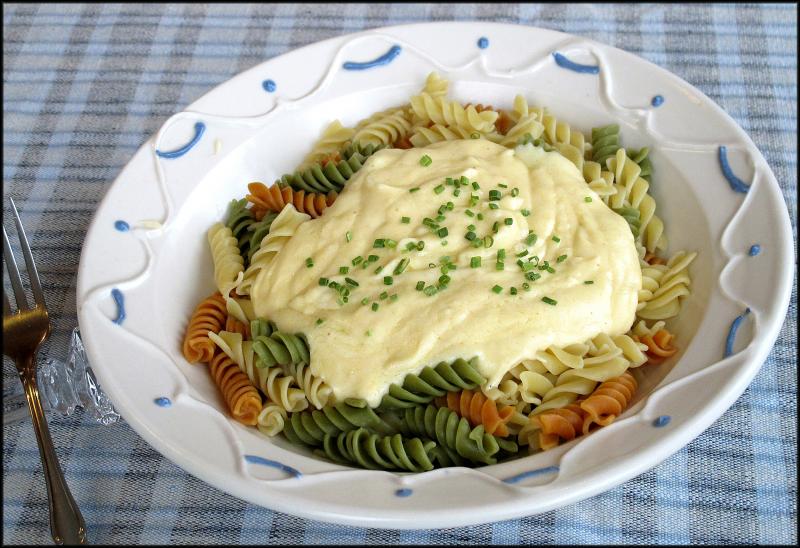Mother sauces provide crowning touch for many dishes
Last week, my friend Debbie LaMorte gifted us a quiche, still warm from her oven. The texture of the custard was perfect, tender and fluffy with hints of onion and nutty Swiss cheese. Once the pie plate was empty, I craved something more, equally delicate and slightly cheesy, which sent me to the cookbook shelf. Of course, I ended up discovering the complex world of sauces.
In traditional culinary arts, the term “mother sauce” is used to describe one of the five basic sauces that form the backbone of so many dishes. Sauces are made from a combination of liquid and thickening agent, followed by specific flavorings. There are five sauces that are considered mother sauces, and each uses a different liquid and thickening method.
Three of these are thickened with a roux, which is made from melted butter and flour, cooked to a desired color. Béchamel or white sauce is the lightest of these, created from roux whisked with milk. Traditional seasonings are onion, bay and cloves, which are simmered in the milk, then removed before making the silky sauce. This is the mother sauce for cheese sauces, like the mornay sauce in the photo.
Another sauce thickened with a light-colored roux is called velouté or blonde sauce. One difference from the previous sauce is that stock is used as the liquid ingredient, most often chicken stock, but you’ll also see versions made from veal or fish stock. There are a number of variations based on velouté, including those mixed with wine or vinegar.
The third sauce thickened with roux is Espagnole or brown sauce. This begins with a dark roux and rich beef stock, then adds tomato paste and a mixture of chopped carrot, celery and onion (known as mirepoix) to create a deeply colored and richly flavored sauce. It’s also a component of a demi-glace, which is one part Espagnole and one part beef stock, cooked until it’s reduced by half.
One of my favorite mother sauces is hollandaise, which is quite different in preparation and ingredients from the previous roux-based sauces. Here, clarified butter serves as the liquid, and egg yolks provide thickening. It’s important to use clarified butter, which is made by heating unsalted butter until the water and milk solids separate from the pure butterfat.
Hollandaise, which is flavored only with lemon juice, is the mother sauce for Béarnaise, which features shallots and tarragon. Béarnaise becomes choron sauce by stirring in tomato paste as the final cooking step. All of these are delicious on steamed vegetables, roast chicken or grilled salmon.
The final mother sauce is tomato sauce, and its assembly can be complex and time-consuming, but worth the investment. This sauce will have a rich tomato flavor, with no acidity or bitterness, and just hints of the aromatics and other ingredients. The secrets to a thick, rich tomato sauce are to render the mirepoix and garlic in salt pork; infuse it with a sachet of bay, thyme, parsley and peppercorns; and simmer it in the oven, not stovetop.
You can transform this basic tomato sauce into sauce Provençale with the addition of Herbes de Provence, capers and black olives. This is delicious over a thick grilled fish such as halibut, and equally good as a replacement for your traditional pasta sauce. Below are recipes to introduce you to two of the mother sauces.
Béchamel (White Sauce)
1 C milk
thick onion slice
3 whole cloves
1 bay leaf
2 T unsalted butter
2 T flour
salt
white pepper
Place the milk in a small saucepan. Stud the onion with the cloves and add to the pan along with bay leaf. Scald the milk over medium-high, removing from the heat when tiny bubbles form around the edges. Allow to sit for 15 minutes, then remove onion, cloves and bay leaf; set aside. Melt the butter in a small saucepan. When it begins to foam, whisk in the flour and cook until slightly thickened. Remove pan from the heat and whisk in the milk. Return to low heat and cook, whisking constantly until thickened and smooth, about 2 or 3 minutes. Season to taste with salt and white pepper.
Mornay (Cheese Sauce)
1 C white sauce
1/4 C finely grated cheese*
pinch cayenne
pinch grated nutmeg
snipped chives for garnish
When the white sauce is smooth and hot, gently whisk in the grated cheese, stirring just until cheese melts. Serve over pasta, vegetables, or fish, garnished with snipped chives. *Note, a mixture of Gruyère and Parmesan is traditional, but you may substitute Swiss or cheddar.
Tomato Sauce
2 oz diced salt pork
4 minced garlic cloves
1 diced onion
2/3 C diced carrots
1/2 C diced celery
2 28-oz cans crushed tomatoes
1 qt veal stock
4 parsley sprigs
1 bay leaf
2 thyme sprigs
5 cracked peppercorns
salt & pepper, to taste
Preheat oven to 300 F. Melt the salt pork in an oven-safe Dutch oven. Add garlic, onion, carrots and celery; sauté until softened, about 4 minutes. Stir in tomatoes and veal stock. Tie the aromatics into a piece of cheesecloth and add to the pot. Bring to a boil, then cover loosely and place the pot in the oven for 2 hours. Remove from oven and discard herb sachet. Use an immersion blender to purée into desired consistency (optional). Season to taste with salt and pepper.























































